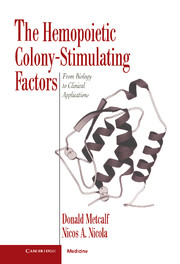Book contents
- Frontmatter
- Contents
- Preface
- 1 Historical introduction
- 2 General introduction to hemopoiesis
- 3 Key techniques in analyzing hemopoiesis
- 4 Biochemistry of the colony-stimulating factors
- 5 Biochemistry of the colony-stimulating factor receptors
- 6 Molecular genetics of the colony-stimulating factors and their receptors
- 7 Biological actions of the colony-stimulating factors in vitro
- 8 The biology of colony-stimulating factor production, degradation, and clearance
- 9 Actions of the colony-stimulating factors in vivo
- 10 Role of the colony-stimulating factors in basal hemopoiesis
- 11 Actions of the colony-stimulating factors in resistance to infections
- 12 Role of the colony-stimulating factors in other disease states
- 13 The colony-stimulating factors and myeloid leukemia
- 14 Clinical uses of the colony-stimulating factors
- 15 Conclusions
- References
- Index
9 - Actions of the colony-stimulating factors in vivo
Published online by Cambridge University Press: 04 August 2010
- Frontmatter
- Contents
- Preface
- 1 Historical introduction
- 2 General introduction to hemopoiesis
- 3 Key techniques in analyzing hemopoiesis
- 4 Biochemistry of the colony-stimulating factors
- 5 Biochemistry of the colony-stimulating factor receptors
- 6 Molecular genetics of the colony-stimulating factors and their receptors
- 7 Biological actions of the colony-stimulating factors in vitro
- 8 The biology of colony-stimulating factor production, degradation, and clearance
- 9 Actions of the colony-stimulating factors in vivo
- 10 Role of the colony-stimulating factors in basal hemopoiesis
- 11 Actions of the colony-stimulating factors in resistance to infections
- 12 Role of the colony-stimulating factors in other disease states
- 13 The colony-stimulating factors and myeloid leukemia
- 14 Clinical uses of the colony-stimulating factors
- 15 Conclusions
- References
- Index
Summary
Two early studies were conducted on the effects of injecting into mice either embryo-conditioned medium containing CSF or semipurified human urinary M-CSF (Bradley et al., 1969; Metcalf and Stanley, 1971). The results suggested that granulocyte and macrophage formation might have been stimulated, but since the injected material was impure, the responses could not be ascribed unequivocally to the injected CSF.
Beginning in the late 1970s, extensive information was accumulated on the in vitro actions of pure CSFs before sufficient purified recombinant CSF was available for testing in vivo. These experiments produced clear expectations of the types of response that might be observed in vivo. The in vitro studies could not, of course, predict the possible occurrence of such responses as the release of cells from the marrow or population shifts between hemopoietic organs. From the in vitro data, GM-CSF and Multi- CSF were expected to be the strongest stimuli for granulocyte formation in vivo and M-CSF to be a strong stimulus for monocyte and macrophage formation.
In the long period before in vivo testing could be commenced, many critics predicted that injected CSFs would elicit no measurable responses for a variety of reasons. Some held that the CSFs were not likely to be genuine regulators, since CSF levels were very low in normal health and became elevated only during infections. Others doubted whether injected CSF could penetrate the tightly packed hemopoietic tissues of the marrow or whether the injection of a single CSF could hope to perturb significantly a homeostatic control system of obvious complexity involving many interacting regulators.
- Type
- Chapter
- Information
- The Hemopoietic Colony-stimulating FactorsFrom Biology to Clinical Applications, pp. 188 - 204Publisher: Cambridge University PressPrint publication year: 1995
- 1
- Cited by



